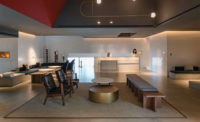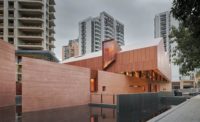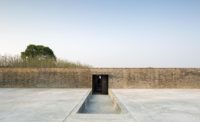With a name that sounds like a rock band and a program inspired by the current biking boom, Onomichi U2 is an uber-cool hotel where cyclists can stay with their wheels. A repurposed warehouse erected in 1943 in a town 45 miles from the city of Hiroshima, Japan, the building includes 28 bike-friendly guest rooms plus assorted shops and eateries. The project is the product of Suppose Architects, the Hiroshima firm headed by Makoto Tanijiri. An avid cyclist himself, Tanijiri scored the commission after winning a competition hosted by Hiroshima Prefecture. What the client had was an old building and an objective of luring visitors to Onomichi, a town of 145,200 on the Inland Sea. What the architect offered was a clever solution that combines history with the here and now.
The two-story hotel fills the warehouse's west end, starting with a reception desk designed so guests can check in while still in the saddle. From there, extra-wide corridors and stairs with narrow bike ramps lead to 14 rooms on each floor. Styled like a traditional engawa, or porch, a raised platform running the length of the first-floor hall gives guests a place to sit and chat with fellow cyclists.
The individual accommodations fit neatly within notches on the building perimeter'former loading areas now filled with greenery. They include 22 standard rooms plus six deluxe ones distinguished by a raised floor and spa-style bathtub. Each room is equipped with a wall-mounted bike hook, heavy-duty flooring, and plenty of dark-gray paint to conceal the inevitable scuffs and scratches. Located along the windowed outer wall, the bathrooms are separated from sleeping areas by privacy curtains and clear-glass partitions that allow daylight into both spaces.
While Tanijiri designed Onomichi U2 for bikers, the original 25,000-square-foot structure was built for trucks carrying cargo to ships going out to sea. Despite its industrial origins, the warehouse did not meet the current earthquake code and required supplemental below-grade beams. Yet even after these reinforcements were installed, the existing reinforced-concrete structure could not support any new loads. So Tanijiri inserted a new lightweight-steel frame to support his architecture, essentially creating a building within a building. 'We treated the inside like an outside site,' explains the designer.
Where nonstructural elements were concerned, however, Tanijiri endeavored to incorporate the old into the new. Capitalizing on the site's shoreline winds, the existing skylights not only bathe the interior with soft daylight but facilitate natural ventilation by drawing hot air up and out. And instead of camouflaging the aged concrete ceiling, the architect left it as is. 'We like the feeling of history,' he says. To that end, he kept the wooden bumpers affixed to the interior walls, the sliding dockside doors (now pinned in place), and painted signage on the building's exterior.
Against this backdrop, Tanijiri's custom furnishings and light fixtures are a refreshing contrast. 'Its like pairing vintage jeans with a new jacket,' comments the architect who even advised on the design of pajamas for the hotel guests. More distressed denim than Issey Miyake Pleats Please, Onomichi U2 finds beauty in things that weren't meant to be beautiful.
PeopleFormal name of building: Location: Completion Date: Gross square footage: Client: Owner: Building owner: Hiroshima Prefecture Architect: Personnel in architect's firm who should receive special credit: Unregistered Architects: Yuji Okanishi, Toshinori Iwatake, Kinuyo Sugiura Interior designer: Engineers: Facility design: Sato Sekkei Consultant(s): Other: Furniture: E&Y Graphic design: UMA/design farm, 10 Inc. Masahiro Kakinokihara and Mayumi Uchida Uniform design: and wander Mihoko Mori, Keita Ikeuchi General contractor: Photographer: Size: 25,000 square feet Completion Date: March 2014 |
ProductsStructural system Windows Glazing Doors Wood doors: IH WOOD WINDOW, Inside doors are original detail. Fire-control doors, security grilles: SANWA SHUTTER CORPORATION Hardware Closers: RYOBI Exit devices: Panasonic Pulls: MIWA LOCK Security devices: Panasoi Interior finishes Paneling: Asano Non combustion Solid surfacing: STONE OFFICE MORISHITA Carpet: UES, UEDA SHIKIMONO Furnishings Fixed seating: E&Y Chairs: E&Y Tables: E&Y Lighting Downlights: MAX RAY Task lighting: Original detail Other unique products that contribute to sustainability: |

















Post a comment to this article
Report Abusive Comment